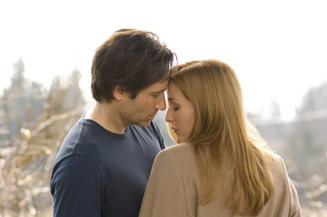Chapter Two
The X-Files: I Want to Believe
By Brett Ballard-Beach
September 15, 2011
Watching the first X-Files movie (aka Fight the Future) this past week for the first time since 1998 reawakened a curious sort of nostalgia for me for the decade. No, that’s not exactly right. Rather, I found myself processing it as the first decade in which, thanks to the dawn of a 24/7 news cycle, the explosion of talk radio outlets, and the beginning rumbles of a world-wide web and planet-unifying social media, the sorts of conspiracy theories that were once relegated to an underground network of kooks and nut jobs passing information around in pamphlets, were thrust into daylight, legitimized, transmitted worldwide, and breathlessly reported as galvanizing journalism.
The show aired during a stretch of American life marked by: Presidential word parsing in regards to the specifics of sexual relations (or lack thereof); the bombing of a federal building in Oklahoma City; government/citizen standoffs that resulted in shootouts and blazes in Waco and Ruby Ridge; the Unabomber Manifesto and the eventual capture and unveiling of one Ted Kaczynski; and the mass suicide of the Heaven’s Gate cult.
The X-Files ventured into the paranormal and unexplainable on a weekly basis mixing and contrasting the fervor and sardonically soaked open-mindedness of FBI agent Fox “Spooky” Mulder with Dana Scully, a fellow agent raised on science and medicine, whose overriding skepticism made her the perfect audience surrogate for those who might not be caught dead watching tales of little green men, evil bureaucrats, and other things that go bump in the night. Although most of its episodes were not “ripped from the headlines”-type stories spun out with a supernatural gloss, the majority of them did invoke the universal specter of fear that was increasingly turned to by news outlets to push their headlines: the fear of government, of cabals of rich and powerful white men in possession of shadowy secrets, of ruthless and malignant “illegal” aliens bent on global takeover. “The truth is out there”, the series’ most notorious tagline urged, but inherent in that simple statement is a binary that was also at the core of the show: if the truth is not among “us”, it must be hidden out somewhere among “them”.
I was never the most regular watcher of the show. If my college friends were shacked up in someone’s dorm room or in the commons lounge on Friday night watching it, I might join them. I do remember checking out the tail end of one of FX’s Viewer’s Choice marathons on what must have been Thanksgiving ’97 - a supremely rotten one in which I both had to work and got my wallet and a just-purchased cassette copy of “Invisible Touch” stolen out of my employee locker - and the ones I did get to see included favorites like “Clyde Bruckman’s Final Repose”, “Musings of a Cigarette Smoking Man”, and the No. 1 pick, the deliciously gothic “Home.”
Standalone episodes were always preferable, truth be told, because I could never completely buy into the mythology episodes. Besides, the show appeared to me to have the most freedom when it was a story that could be told in 45 minutes and would have little to no effect on future installments. Standalones often offered a tone that was more humorous, if not downright jokey, than those that comprised the series’ arc and I feel that humor was the series’ stealth weapon and its most undervalued asset. I did become a regular in the home stretch, watching every episode in the 2000-2001 season after David Duchovny was no longer a regular, and Robert Patrick and Annabeth Gish were brought on as the Coy and Vance Duke of the FBI’s paranormal activities wing.
Continued:
1
2
3
4
|
|
|
|




